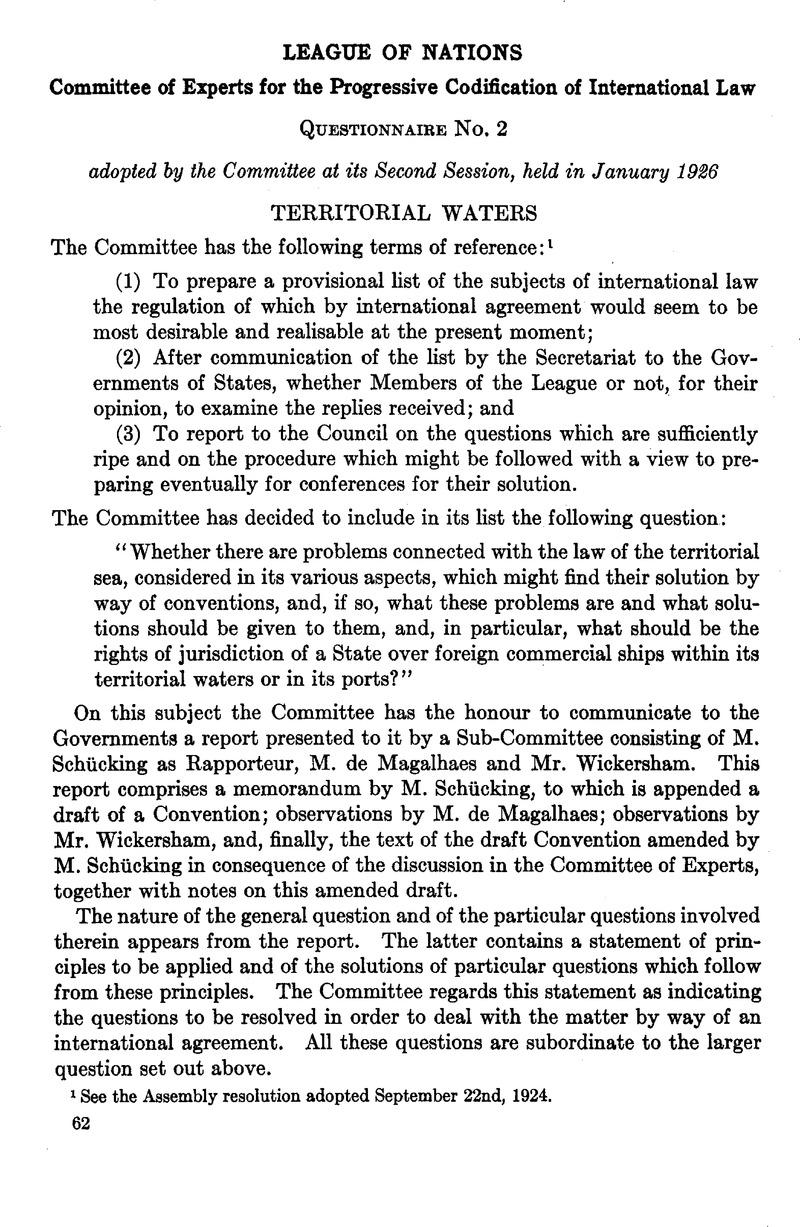No CrossRef data available.
Article contents
Questionnaire No. 2.—Territorial Waters
Published online by Cambridge University Press: 04 May 2017
Abstract

- Type
- Second Session of the Committee of Experts for the Progressive Codification of International Law
- Information
- American Journal of International Law , Volume 20 , Issue S5: Supplement: Codification of International Law , October 1926 , pp. 62 - 147
- Copyright
- Copyright © American Society of International Law 1926
References
1 See the Assembly resolution adopted September 22nd, 1924.
1 See page 141.
1 Draft for the Regulation of Maritime Communications in Peace-time, submitted to the Stockholm Conference of the International Law Association in 1924.
2 “ Territorial Waters, with Special Reference to Norwegian Legislation,” memorandum presented to the Stockholm Conference of the International Law Association in 1924.
3 “ The Principal Facts concerning Norwegian Waters.”
1 Fauchille, after asking the question: “les progrès de la science, et spécialement les progrès de la science aéronautique, ne devront-ils pas avoir nécessairement une influence sur la détermination de la mer territoriale?” reproduces passages from the article entitled “L’Aviation sur les eaux territoriales,” published by M. Henry Couannier, in the Revue juridique internationale de la Locomotion aérienne, Vol. IV, pp. 252 et seq., and concludes as follows: “Pour être logique jusqu’au bout, c’est donc, d’après M. Henry Couannier, cette portée (celle de la vue d’un avion) qu’il faudrait admettre comme mesure de la zone territoriale; et ainsi la longueur de cette zone devrait être d’environ 15 milles, au lieu de 6.”
2 It should be mentioned here that the necessity of extending the zone of the territorial sea in case of war has also been recognised (1894 draft of the Institut de Droit international).
Although, according to a statement by the Committee, we are not called upon for the moment to consider the codification of the public international law of war, that aspect of the problem ought not to be forgotten.
1 In the treaties of October 2nd, 1885, and March 27th, 1893, Spain and Portugal mutually agreed that fishing within a limit of six miles should be reserved exclusively to the nationals of each of the two countries and that the use of destructive appliances should be prohibited within a limit of twelve miles.
1 As águas territorials e as pescas. Memorandum to the Seventh International Fishery Congress, Santander, 1921, by Vicente Almeida D’Eça, delegate of the Portuguese Government, p. 11.
1 In the Grange case (Delaware Bay), 1793.
2 “Une certaine catégorie de baies, qui peuvent être appelées les baies historiques, forment une classe distincte et à part et sans aucun doute appartiennent au pays riverain, quelles que soient la profondeur de pénétration et la largeur de leur ouverture, quand ce pays a affirmé sa souveraineté sur elles et que des circonstances particulières, telles que la configuration géographique, l’usage immémorial et par-dessus tout les nécessités de la défense justifient une telle prétention.”—Revue de Droit international public, Vol. XIX, p. 482.
1 Emer de Vatel, M. de Martens, etc.
1 See p. 144.
1 The Extent of the Marginal Sea, Henry G. Crocker, p. 598.
2 Lushington, p. 295.
1 The Sovereignty of the Sea, Thomas W. Fulton, p. 661.
2 Ibid., p. 664.
3 Oppenheim, International Law, Vol. I, p. 340.
1 Lushington, 295. See also Kent, AA, Commentaries on International Law (Abdy edition), 1878, pp. 103-104.Google Scholar


